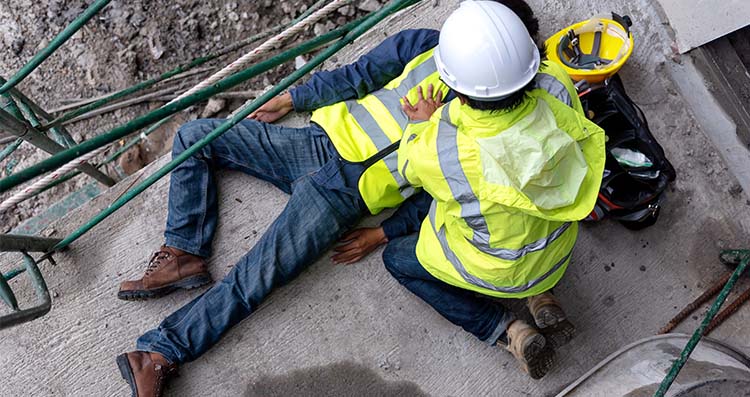How do you prevent permanent trauma after a serious occupational accident?
A serious occupational accident can lead to permanent consequences,
both physical and mental. We asked Daisy Buttiens, prevention adviser for psychosocial aspects (PAPSY) at Mensura, and her colleague Bjorn Christis, prevention adviser for occupational safety, how you can deal with it as a concerned colleague, prevention adviser, or employer.
How do we define a serious occupational accident and trauma?
Bjorn: “A serious occupational accident is a fatal occupational accident or one that meets certain conditions. It involves the combination of an injury and an anomalous event and/or object, for example, a bone fracture resulting from a collapse of an overhead structure.”
Daisy: “An event is potentially traumatic if it meets the following 4 characteristics:
an unexpected and uncontrollable event that feels overwhelming and which shatters our illusion of invincibility. We all know an occupational accident can happen, but this illusion of invincibility makes us think it won’t happen to us. That way, we don’t leave for work every morning anxious.
By the way, a traumatic event does not necessarily lead to permanent trauma. This is only the case when the person still hasn’t recovered from the initial – normal – symptoms after several months. By recognising potentially traumatic events and responding to them correctly, you can prevent those lasting consequences.”

What does a ‘normal’ response to trauma look like?
Daisy: “In that first moment, every response is a normal response: screaming, silence, laughing loudly,… Your body enters a heightened state of stress and everyone reacts differently.
The most important thing is that you are able to release the built-up tension. Allow those releases and emotions; they’re a part of the process. And talk about it with someone you know and trust. The only thing that doesn’t work is being alone.”
Bjorn: “So far, I have assisted one company in the aftermath of a fatal occupational accident.
A young man of barely 20 years old had been pinched between two machines. I’ll never forget it: the crying parents and friends, the anger and dejection, the guilt of those left behind, the body at the medical examiner’s,… At such a moment, as a prevention adviser, you have to switch off your emotions and look at the facts: taking witness statements and writing a report from your role as an expert. What happened here and how do we avoid this in the future?”
What happens when those initial emotions sink in?
Daisy: “After the sheer release comes recovery. For many people, these extreme emotions lead to panic, but we let them see that it is a healthy, restorative response. Relapses and nightmares are intense, but also a sign that recovery has begun.”
“People possess a natural resilience, which comes out especially with others by your side.
So talk about your feelings and listen to your body. We’ll check in with you after a month to see how your recovery is progressing. Are you still often crying in bed, but starting to leave the house again? Then your body is recovering; allow yourself to experience that pain. It’s important that you don’t become fixed in your avoidance patterns.”
“Do you feel like you’ve hit a processing plateau? That’s what we mean by trauma.
The accumulated tension has not found its way out and has got ‘stuck’ in your body. In that case, we’ll refer you to a trauma psychologist to confront and release that tension in a safe environment.”
Bjorn: “When I spoke to the witnesses of the fatal occupational accident, I also noticed that many only remembered some snippets from the event. Usually, such a report must be completed within ten calendar days, but after consulting with the company’s PAPSY and the FPS Directorate General Control on well-being at work (TWW), we gave the witnesses some extra time. After they calmed down, we were able to put the pieces of this memory back into place. And that was actually also a form of processing.”

As a prevention adviser, how do you avoid taking on those emotions yourself?
Daisy: “Tough emotions are part of the job, but that doesn’t mean they can’t affect you anymore. You get training on it at Mensura, so you have the knowledge and tools to maintain control.
If an event really hits you hard, above all, don’t go feeling all super strong just because you’re a psychologist. Call someone you know so you can release those emotions in a safe space.”
Bjorn: “Every time I see that exact machine, I can still see that young man lying there. The PAPSY involved contacted me for a talk after the accident, and we always discuss such occupational accidents as a group at Mensura. I got a lot of comfort out of that.”
As an employer, how do you deal with a traumatic serious occupational accident?
Bjorn: “Production activities were temporarily halted in the company where the fatal occupational accident occurred. In consultation with the PAPSYs and the FPS TWW, and after taking the necessary preventive measures, the various lines were systematically restarted.
You can really see a difference now in terms of safety culture. Everyone is now putting maximum effort into safety so that they never have to go through this again.”
Daisy: “Employers find themselves in a dilemma. On the one hand, your business has to keep running because long downtimes are not always financially feasible. On the other hand, people are sometimes unable to get back on track right away. They see that machine and they relive the accident.”
“The power of connection is still greatly underestimated here. Involve your employees:
‘we know this is difficult – how can we help you?’ Give them control and organise regular
check-ins after start-up. When people feel connected, they can do more than you think.”
Want to know more about how to assist employees after a traumatic experience?
In the ‘Trauma management for supervisors and managers’ training course, you’ll learn how to create a safe working environment for employees who are experiencing post-traumatic stress.